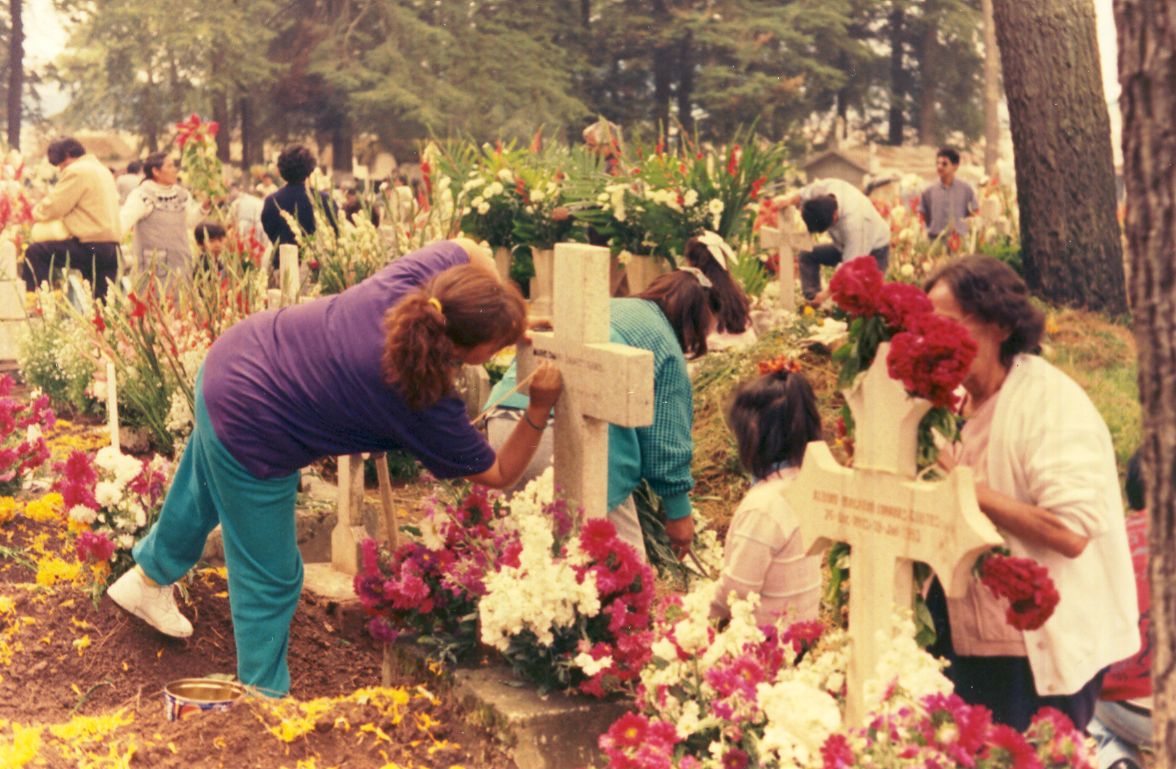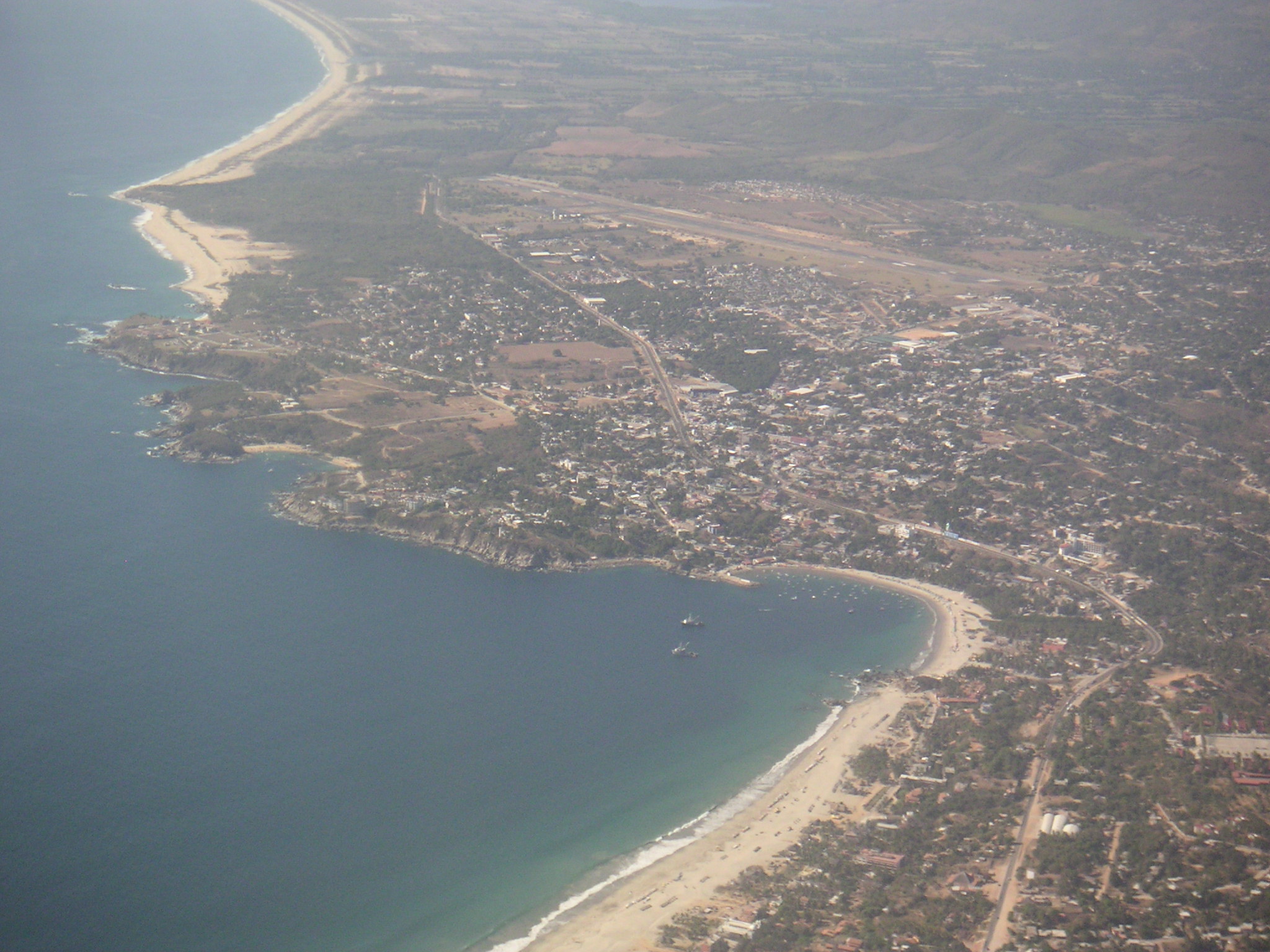|
Santos Reyes Nopala
Santos Reyes Nopala is a town and municipality in Oaxaca in south-western Mexico. It is part of the Juquila District in the center of the Costa Region. The name Nopala is derived from the Nahuatl word for nopatlan, Environment The municipality covers an area of 196.48 km² at a height of 460 meters above sea level. It is located in a valley near to the Pacific coast. The climate is tropical and humid, with an average temperature of 26 °C, rising in late spring and early summer to 35 °C. Flora is typical of the warm region, including palm trees and a wide variety of plants. Wildlife include deer, badgers, iguana and armadillo. History Nopala was founded around 800 BC, and reached its heyday between 500 and 700 AD during what is called the "Cerro Iglesia" (Church Hill) period. During this phase the community was about five miles north of its current location on a hill that overlooks the Pacific Ocean. The site contains important stone structures including a ball ... [...More Info...] [...Related Items...] OR: [Wikipedia] [Google] [Baidu] |
Municipalities Of Mexico
Municipalities ('' municipios'' in Spanish) are the second-level administrative divisions of Mexico, where the first-level administrative division is the ''state'' (Spanish: estado). They should not be confused with cities or towns that may share the same name as they are distinct entities and do not share geographical boundaries. As of January 2021, there are 2,454 municipalities in Mexico, excluding the 16 boroughs of Mexico City. Since the 2015 Intercensal Survey, two municipalities have been created in Campeche, three in Chiapas, three in Morelos, one in Quintana Roo and one in Baja California. The internal political organization and their responsibilities are outlined in the 115th article of the 1917 Constitution and detailed in the constitutions of the states to which they belong. are distinct from , a form of Mexican locality, and are divided into '' colonias'' (neighborhoods); some municipalities can be as large as full states, while cities can be measured in b ... [...More Info...] [...Related Items...] OR: [Wikipedia] [Google] [Baidu] |
Mixtec
The Mixtecs (), or Mixtecos, are indigenous Mesoamerican peoples of Mexico inhabiting the region known as La Mixteca of Oaxaca and Puebla as well as La Montaña Region and Costa Chica Regions of the state of Guerrero. The Mixtec Culture was the main Mixtec civilization, which lasted from around 1500 BC until being conquered by the Spanish in 1523. The Mixtec region is generally divided into three subregions based on geography: the Mixteca Alta (Upper Mixtec or Ñuu Savi Sukun), the Mixteca Baja (Lower Mixtec or Ñuu I'ni), and the Mixteca Costa (Coastal Mixtec or Ñuu Andivi). The Alta is drier with higher elevations, while the Baja is lower in elevation, hot but dry, and the Coasta also low in elevation but much more humid and tropical. The Alta has seen the most study by archaeologists, with evidence for human settlement going back to the Archaic and Early Formative periods. The first urbanized sites emerged here. Long considered to be part of the larger Mixteca re ... [...More Info...] [...Related Items...] OR: [Wikipedia] [Google] [Baidu] |
Party Of The Democratic Revolution
The Party of the Democratic Revolution (PRD, es, Partido de la Revolución Democrática, ) is a social democratic political party in Mexico. The PRD originated from the Democratic Current, a political faction formed in 1986 from the Institutional Revolutionary Party (PRI). The PRD was formed after the contested general election in 1988, which the PRD's immediate predecessor, the National Democratic Front, believed was rigged by the PRI. This sparked a movement away from the PRI's authoritarian rule. As of 2020, the PRD is a member of the Va por México coalition. Internationally, the PRD is a member of the Progressive Alliance. The members of the party are known colloquially in Mexico as ''Perredistas''. History Early origins Break from the PRI (1986–1988) The PRD has its origins with the leftist members of the PRI, Institutional Revolutionary Party. The PRI had dominated Mexican politics since its founding in 1929. In 1986, a group of PRI members – including Ifig ... [...More Info...] [...Related Items...] OR: [Wikipedia] [Google] [Baidu] |
Day Of The Dead
The Day of the Dead ( es, Día de Muertos or ''Día de los Muertos'') is a holiday traditionally celebrated on November 1 and 2, though other days, such as October 31 or November 6, may be included depending on the locality. It is widely observed in Mexico, where it largely developed, and is also observed in other places, especially by people of Mexican heritage. Although related to the simultaneous Christian remembrances for Hallowtide, it has a much less solemn tone and is portrayed as a holiday of joyful celebration rather than mourning. The multi-day holiday involves family and friends gathering to pay respects and to remember friends and family members who have died. These celebrations can take a humorous tone, as celebrants remember funny events and anecdotes about the departed. Traditions connected with the holiday include honoring the deceased using calaveras and marigold flowers known as ''cempazúchitl'', building home altars called '' ofrendas'' with the favorite ... [...More Info...] [...Related Items...] OR: [Wikipedia] [Google] [Baidu] |
Judeo-Christian
The term Judeo-Christian is used to group Christianity and Judaism together, either in reference to Christianity's derivation from Judaism, Christianity's borrowing of Jewish Scripture to constitute the "Old Testament" of the Christian Bible, or due to the parallels or commonalities in Judaeo-Christian ethics shared by the two religions. The term "Judæo Christian" first appeared in the 19th century as a word for Jewish converts to Christianity. In the United States the term was widely used during the Cold War in an attempt to suggest that the United States had a unified American identity which was opposed to communism. Theologian and author Arthur A. Cohen, in ''The Myth of the Judeo-Christian Tradition'', questioned the theological validity of the Judeo-Christian concept, instead, he suggested that it was essentially an invention of American politics. The use of Abrahamic religions as a term for the common grouping of faiths which are attributed to Abraham, the Baháʼ� ... [...More Info...] [...Related Items...] OR: [Wikipedia] [Google] [Baidu] |
Chatinos
The Chatinos are an indigenous people of Mexico. Chatino communities are located in the southeastern region of the state of Oaxaca in southern central Mexico. Their native Chatino language are spoken by about 23,000 people (Ethnologue surveys), but ethnic Chatinos may number many more. The Chatinos of San Juan Quiahije call themselves ''neq-a tnya-j'' and their language ''Chaq-f tnya-b''. Chatino populations are found in the following Oaxacan municipalities, mostly in the area around Juquila: Santos Reyes Nopala, San Juan Quiahije or KichinA kiqyaC, San Miguel Panixtlahuaca or KchinA SkwiE, Santiago Yaitepec or KeG XinE, Santa Cruz Zenzontepec or QyaC ytiB, San Juan Lachao or TsoH, Santa María Temaxcaltepec or XyanA, Santa Catarina Juquila or SqweF and Tataltepec de Valdés or LoA qoJ. The region that the Chatinos inhabit is rich in natural resources. Traditionally many Chatino people have been involved in agriculture, which depends very much on the climate, so some Chatino ... [...More Info...] [...Related Items...] OR: [Wikipedia] [Google] [Baidu] |
Nopala
Nopala (officially: Nopala de Villagrán; Otomi: ʼMostʼä) is a town and one of the 84 municipalities of Hidalgo Hidalgo (state), Hidalgo is a Administrative divisions of Mexico#States, state in central Mexico divided into 84 municipalities of Mexico, municipalities. According to the 2020 Mexican Census, Hidalgo is the States of Mexico, 16th most populous st ..., in central-eastern Mexico. The municipality covers an area of 334 km2. As of 2005, the municipality had a total population of 15,099. References Municipalities of Hidalgo (state) Populated places in Hidalgo (state) {{Hidalgo-geo-stub ... [...More Info...] [...Related Items...] OR: [Wikipedia] [Google] [Baidu] |
Zapotec Peoples
The Zapotecs ( Valley Zapotec: ''Bën za'') are an indigenous people of Mexico. The population is concentrated in the southern state of Oaxaca, but Zapotec communities also exist in neighboring states. The present-day population is estimated at approximately 400,000 to 650,000 persons, many of whom are monolingual in one of the native Zapotec languages and dialects. In pre-Columbian times, the Zapotec civilization was one of the highly developed cultures of Mesoamerica, which, among other things, included a system of writing. Many people of Zapotec ancestry have emigrated to the United States over several decades, and they maintain their own social organizations in the Los Angeles and Central Valley areas of California. There are four basic groups of Zapotecs: the ', who live in the southern Isthmus of Tehuantepec, the ', who live in the northern mountains of the Sierra Madre de Oaxaca, the southern Zapotecs, who live in the southern mountains of the Sierra Sur, and the Centr ... [...More Info...] [...Related Items...] OR: [Wikipedia] [Google] [Baidu] |
Administrative Divisions Of Mexico
The United Mexican States ( es, Estados Unidos Mexicanos) is a federal republic composed of 32 federal entities: 31 states and Mexico City, an autonomous entity. According to the Constitution of 1917, the states of the federation are free and sovereign in all matters concerning their internal affairs. Each state has its own congress and constitution. Federal entities of Mexico States Roles and powers of the states The states of the Mexican Federation are free, sovereign, autonomous and independent of each other. They are free to govern themselves according to their own laws; each state has a constitution that cannot contradict the federal constitution, which covers issues of national competence. The states cannot make alliances with other states or any independent nation without the consent of the whole federation, except those related to defense and security arrangements necessary to keep the border states secure in the event of an invasion. The political organiza ... [...More Info...] [...Related Items...] OR: [Wikipedia] [Google] [Baidu] |
Nahuatl
Nahuatl (; ), Aztec, or Mexicano is a language or, by some definitions, a group of languages of the Uto-Aztecan language family. Varieties of Nahuatl are spoken by about Nahua peoples, most of whom live mainly in Central Mexico and have smaller populations in the United States. Nahuatl has been spoken in central Mexico since at least the seventh century CE. It was the language of the Aztec/ Mexica, who dominated what is now central Mexico during the Late Postclassic period of Mesoamerican history. During the centuries preceding the Spanish and Tlaxcalan conquest of the Aztec Empire, the Aztecs had expanded to incorporate a large part of central Mexico. Their influence caused the variety of Nahuatl spoken by the residents of Tenochtitlan to become a prestige language in Mesoamerica. After the conquest, when Spanish colonists and missionaries introduced the Latin alphabet, Nahuatl also became a literary language. Many chronicles, grammars, works of poetry, administrative ... [...More Info...] [...Related Items...] OR: [Wikipedia] [Google] [Baidu] |
Costa Region, Oaxaca
The Costa Region or Costa Chica lies on the Pacific coast of the state of Oaxaca, Mexico, south of the more mountainous Sierra Sur inland from the coast. It includes the districts of Jamiltepec, Juquila and Pochutla. Climate The region has a tropical climate in the coastal plain, with a more temperate climate higher up. Average temperatures range between , and maximum annual rainfall is between - Economy The population is mainly engaged in agriculture and waterfront fisheries. One of the best coffees in the world, the Pluma Hidalgo, is cultivated in the Pochutla district. In other parts of the region lemons are grown to make lemon oil, a raw material for perfumes and medicines. Pine and oak wood is harvested for plywood. Ranching is a major source of revenue. There is also small-scale exploitation of iron, copper and magnesium, and the region has titanium deposits. It is a tourist region, based on the beaches of Huatulco and Puerto Escondido. To develop this industry, ... [...More Info...] [...Related Items...] OR: [Wikipedia] [Google] [Baidu] |





